Yoga is a science which unites the body to the mind and mind to the God. Here I have discussed some simple and non harming yogic exercises especially for those who want to work as reiki practitioner.
Padmasana (Lotus Pose)
It is called Padmasana because while performing it, legs appear in the form of a lotus.
Method : Sit on the ground and stretch forward your legs, keeping them together. Now left foot should be placed over the right thigh, and right foot over the left thigh, making sure that the heels touch the abdomen on both sides on the either side of nail. Keep the hands on the knees. Keep the head and back portion erect. Both the feet should touch the ground, and eyes be kept closed. This asana can be utilised for doing Pranayama. If you wish, you can join index finger and thumbs, base of thumb resting on index finger’s nail, a sign of Pranayama Mudra.

Benefits : It is very useful to gain concentration of mind, to enhance mental faculties, to do mental work, especially useful for the aged person. It prevents trapping of wind in the body, preserves vital fluids of the body, imparts solace, peace, solitude and longevity. It tones up reproductive organs and system of females, prevents and cures abdominal disorders. For dhyana (meditation), Padmasana is unique and ideal.
Vajrasana (Thunderbolt Pose)
It is named thunderbolt, as it imparts the strength to body as if it is made like a stone or as strong as a thunderbolt. It is the only asana, in yoga, which can be practised after 45 minutes or more from the time of finishing your meals. In between meal times, it can also be done, but never immediately after meals.

Method : Kneel down on the floor, letting your big toes, legs and knees touch the ground. Now rest your buttocks on your knees, your heels bent inwards and thumbs touching each other. Place the palms on the knees, keeping your spine erect but relaxed and flexible. Breathing should be even, deep and slow. Expand your chest, drawing the abdominal muscles inwards.
Benefits : This asana will expel gas and remove acidity. How much you have overeating, it will digest the same. It tones up sexual system of both males and females, removes pain and stiffness in spine and knees, lowers raised blood pressure, gives longevity and retards and postpones old age. For meditation, it is an ideal asana, as you can sit in this asana as long as you wish. After completion of this asana, simply massage with your hands or, still better, use salt mixed oil, say of mustard, which can be slightly luke-warmed.
Sarvangasana (Pan Physical Pose)
Method : Lie flat on the ground, your spine touching the floor, stretch the body, raise the legs slowly and let them stay at right angle to the trunk. After staying for a few seconds slowly raise up the body, without giving any jerk to the spine. Take help of the hands, keeping the fingers outward and thumbs towards the belly. Slowly go on raising the back until the whole trunk is at 900 and the entire weight comes on the shoulders and neck. Take the legs slightly forward and press the chest with your chin. After remaining in the said pose for a few seconds come to the original position.

Benefits : This asana cures constipation, dyspepsia, has a salutary effect on thyroid gland, tones up the nervous system, all limbs of the body, helps to preserve and thicken semen, is useful in intestinal disorders, varicose veins, appendicitis, renders spine flexible, throat disorders are removed, gas is expelled. In addition, it gives glow, vitality and strength to the body, increases sex power, removes menstrual disorders. Persons with hypertension and cardiac problems should never take to this asana, except under advice and guidance and supervision of a yoga teacher.
Bhujangasana (Serpent Pose)
Method : Lie flat on the ground, abdominal portion touching the ground. Straighten both the arms, palms touching the ground. Now bring the palms at level with both sides of abdomen. Slowly lift your neck and torso in such a way that whole body rests on your palms. Now lift your neck upwards gradually and try to look upwards as far and as conveniently you can. Let the toes touch the ground and palms securely resting on the ground. Do not let your elbows bend down. Stay in this position as long you can. When you feel suffocated or when there is a feeling that you can’t endure/continue any more, then slowly get back to original position from where you had started. After the asana is over, loosen your limbs and relax.

Benefits : Abdominal muscles and back portion are supplied with blood and blood circulation in general is improved and also fresh and pure blood is supplied to all the organs. It imparts strength, flexibility and tone to spinal column. It removes menstrual disorders and irregularity, helps to improve digestion, chance of night discharge is dispelled, helps to maintain celibacy. It is useful for diabetics, as it activates the pancreas, thereby causing secretion of insulin, render arms, hands and neck painless, flexible and active. Kidneys and intestines also are strengthened. It removes obesity and sheds extra flesh from the abdominal portion, and spinal curvature and postural abnormalities are also removed.
Dhanurasana (Bow-Shaped Posture)
Method : Lie flat on the ground, your abdominal side touching the ground. Fold your legs from the knees. Now lift your neck and torso, gradually keeping your hands along sides of your back. Try to catch hold of your ankles with your hands. Gradually stretch your hands and feet so that they form a bow-shape. Stay in this position as long as you can. Then regain the former position and relax by loosening your limbs.
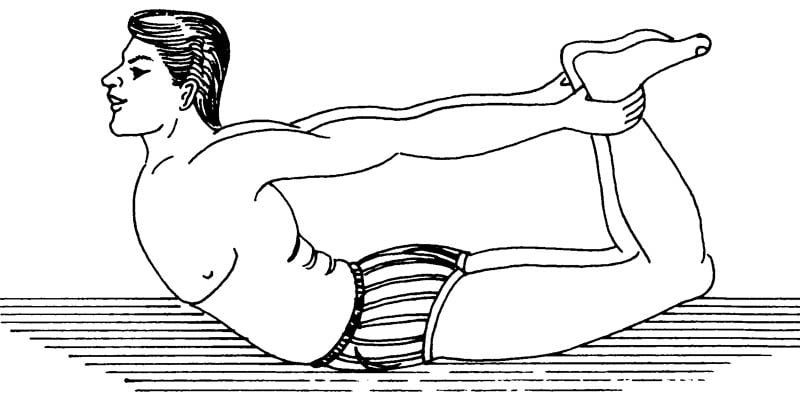
Benefits : It has all the benefits detailed under Bhujangasana, as it is simply and extended form of the former. When you are doing Dhanurasana, there is hardly any need for practising Bhujangasana. Its added benefits are in strengthening of hands, elbows, ankles, knees. In short, both the lower and upper extremities become more flexible and strong, abdominal pressure helps in secretion of digestive juice and activities of endocrine glands. In both these asanas, no jerk should be exerted on any organ. This suggestion is good for all other asanas too. Pregnant ladies must not perform this asana.
Gomukhasana (The Cow-Face Posture)
Method : Sit on the floor, keeping the legs stretched forward. Fold the left leg at the knee and sit on the left foot with the help of hands, fold the right leg and place the right thigh on the left thigh. Bring heels of both the feet together so that they touch each other which can be done by lifting your buttocks a bit. Now bend your right arm from the ear (right side) and bring the hand on the back side of your end. Fold the left hand behind your back and try to form a hook in which both the hands are clasped. Care should be taken not to over exert your limbs. Gradually you will get to the desired position as your limbs attain flexibility. Keep yourself in this position for about 30 seconds. Thereafter, give yourself some pause and reverse the position of hands and legs. If a lady wishes to develop her breast on a particular side, she should perform this asana more with the hand of that side (on which she wishes to develop her breast).

Benefits : This asana is equally beneficial for both the males and females, as it strengthens the muscles of shoulder, chest/breast and makes legs stronger. Muscles of relevant organs are also rendered elastic. After completing the asana, whether on either or both sides, never strain your limbs. Initially, you may find it convenient to perform the asana on one side only, but regular practice will remove all the hesitancy and stiffness, thus making way for you to do the asana on the other side too.
Chakrasana (The Circle Pose)
Method : On a hard surface, lie flat on your back. Later, raise the middle portion of your body upwards, fixing and keeping firmly both the feet and hands on the ground thus making a semi-circle, ensuring that your head keeps between your hands. Now concentrate your eyes on something that lies infront of you.
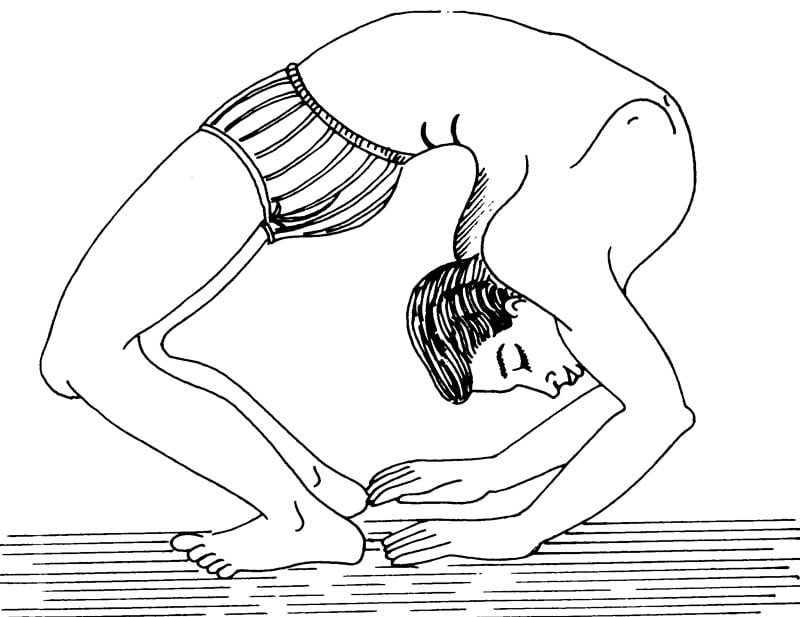
Benefits : It enhances strength of head, throat, neck, abdomen, legs, hands and, in short, all parts of your body, eliminates pains in joints, removes extra fat from the abdominal area, activates digestive system, renders spinal column elastic and supple, imparts glow and agility to the body, normalises posture and stance, and the body stays erect even during the advanced age. Pregnant ladies should not practice this asana as it can adversely affect their pregnancy process, even leading to miscarriage and bleeding.
Kagasana (The Crow Pose)
This asana can be done 3 or more times in a day at the rate of 30 seconds per asana or more.
Method : Squat on the floor. Keep the arms between your heels and legs, heels being raised on toes. Now, place both the palms flat on the ground (infront), while keeping arms in line and shoulders stretched out as much as possible. Thereafter, raise your body on the toes and endeavour to put pressure on your already spread hands. Remain in this position from 30 seconds to 1 minute and then retrace to the original position and finally relax.

Benefits : This posture helps to diminish the unwanted arches on the spine by helping it to elongate, it strengthens muscles of arms and shoulders, helps to activate hormonal secretions. Old, emaciated and pregnant ladies should resist from doing this asana. Those who have pains in arms, hands and fingers should also abstain, as weak limbs may not be able to withstand weight of the body. This asana should be practised, like many other, on empty stomach only.
Kukkutasana (The Cock Pose)
Method : Sit in the position of Padamasna. Insert the hands between the opening of thighs and calves. Now push down the hands and plant them firmly on the floor, keeping your fingers fully spread. Now, after that, push the legs and thighs up your arms. In doing so, your hands turn full so that you could exert desired and sustainable force in lifting the body up. Keep your torso in and upright position, as far as possible. Remain in the final position for a minute or so.

Benefits : Your chest and shoulder muscles become firm due to pressure on them. It also develops and hardens breast-line of those females who have small breasts, provided they practise this posture for quite some time.
Mahavirasana (Named after Lord Hanuman)
Method : Stand erect, bringing forward one foot to a distance of 3 feet from the other. Clench fists of both the hands and raise them. Now, go on jumping alternatively on both the feet, changing the pressure on each feet alternatively. Keep your lips to each other and breath through nose only. When you are tired, take pause until you regain strength to resume the asana. Loosen your limbs and relax.

Benefits : It increases height, sheds extra weight from the waist, body is rendered stronger, chest expands, legs, arms and feet gain strength. It increases sexual power, especially of men, restores normalcy to menstrual cycle of women.
Mayurasana (Peacock Pose)
Method : Stand erect alongside of a table. Place both the hands firmly on top of the table. Fold your both elbows in such a way that the elbows touch and remain firmly (touched) near navel. Now, exert whole weight on your hands, by lifting your body at 1800 and try to stay in this position for 40-50 seconds, increasing the duration gradually or alternatively, spread some blanket or still better lie flat on ground. Firmly affix your hands on ground, your elbows remaining affixed on either side of navel. Now lift your body and put entire weight of body on the hands. Stay in that position for 40 seconds, gradually increasing the duration, depending on your capacity. After staying in that position, very slowly regain the original position and relax.

Benefits : Increases digestion and appetite. Intestines gain strength, constipation and indigestion are dispelled. Liver and kidney disorders get relieved. Above all, if any one have taken poison or poisonous food, it will remove the poison and its effects. It is well known that the snake is eaten by the peacock and its name justifies its utility, as it helps to strengthen the body. Pregnant ladies must not do this asana.
Note : Maximum benefits from the said and other asanas can be derived only when performed properly without exceeding your physical capacity, keeping in view your state of health. To derive optimum benefits, to cure a particular disease or disorder, precision and correctness with which an asana is performed and whether all the relevant procedures have been complied with, are the factors which can ensure utility of an asana.
To start with, proper guidance, or how, what and where of each asana intended to be performed should be guided by a yoga teacher and his guidance sought, if and when some problem is encountered. Never exert undue strain on your body because all asanas cannot be performed by all persons and also all asanas are not required to be done by all. Books on yoga, however precise and meticulous they may be, will only give you an initial motivation in the form of a launching pad. Without a guru, knowledge gained remains half-baked, hence do not forget what you are expected to do and what not.
Parvatasana
Method : Sit in Padmasana (that is by keeping left foot on the right thigh and right foot on the left thigh). Inhale breath and raise both the hands towards the sky, keeping all the fingers apart and stretching both arms without bending either of them. Stay in the said position as per your capacity and convenience, but do not overdo. Before you get suffocated, gradually bring down both the arms and place on both the knees and relax, but without binding your back. Keep spinal column erect at 900. The process can be repeated a number of times. In normal conditions ladies can also perform this asana, but never during pregnancy.

Benefits : This asana imparts flexibility to the spine, strengthens arms, expands chest, and adds to strength of fingers. Improves flexibility of shoulder blades. It improves upon asthmatic condition and tones up uterus.
Yanasana
While performing this asana, body assumes shape and form of a plane flying in the sky; here its nomeclation as such.
Method : Lie flat on the floor, while your abdomen touches the ground. Keep both the feet touching each other. First inhale and then raise your head, neck, hands, chest and feet above the ground, keeping all these organs tight and straight; only your abdomen touching the ground. When you feel you cannot retain the inhaled breath. Relax and loosen your limbs. After sometime, it can be repeated 3-4 times or even more, if capacity permits. Even while maintaining normal breath, this asana can also be performed. Pregnant women must never perform this asana.

Benefits : This asana helps to strengthen bones of arms, hands, shoulders, and legs and also imparts flexibility to the spine. If performed regularly, it can add to inches also.
It removes extra fat, improves digestion, removes almost all uterine disorders, and keeps the body supple. This asana is not suitable for pregnant ladies.
Forward Bending Asana
Method : Stand erect and keep the feet apart at a distance of 6″ to lift. Now gradually bring down the hands and try to touch the ground in front of your toes. While doing so, exert no pressure nor strain unduly. If initially you cannot touch the ground, it is advisable to bend only to the extent possible. As your back and spine become supple, process will look much easier. Do not bend knees and elbows, keeping your neck straight at 1800 while your eyes are affixed looking at the ground or at your hands.
Benefits : This asana elongates legs and arms, makes spine flexible and supple, improves eyesight, strengthens bones and muscles of legs and hands, and does away with trembling. Persons with backache, hip-joint disease and pregnant ladies must not perform this asana. It also strengths heart, improves cardiac output and efficiency. Improves respiration.
Note : As a general rule any forward bending asana or any physical exercise should never be performed by persons having stiff back, backache and lumbar/spinal spondylisis/ curvature. Backward bending asana/exercise may be performed if advised by the concerned experts.
Matsyasana
Method : Sit in Padmasana and thereafter lie down on your back. Catch hold of big toe of feet with hands and rise up your back portion in a gradual manner. In this position your backside of head and knees should continue to touch the ground. Retain breath as long you can and stay in the final position and exhale while returning to the previous state.

Benefits : It strengthens chest and lungs, removes extra fat from hips, strengthens legs and hands, dispels asthma, and removes constipation. In normal health conditions ladies can perform this asana, but not during pregnancy.
Pashchimottanasana
Method : Sit on the floor and spread both legs infront of you and hold each of your big toes with both the hands, but do not let your knees bend. In order to catch the toes you have to bend the back. Initially it may seem slightly difficult to do so, due to rigidity of muscles and limbs; hence do not exert but gradually posture. In 4-5 sitting your body will get attuned to the final posture. Persons with back pain and stiff and muscles, pregnant ladies should not perform this asana unless and until advised by a doctor or yoga expert.

Benefits : It strengthens legs, arms and renders the spine flexible and supple, improve digestion, removes fat on and around abdomen, constipation fortifies and rejuvenates energy and nervous system, lengthens leg bones, purifies blood, improves liver, cardiac and respiratory processes, removes fat from hips and sideways. Note : Those who get adept on this asana, may try to touch their knees with the nose but in the changed position also knees shouldn’t be bent.
Janushirasana
Method : Sit on the floor and fold leg from the knee and place heel of left leg below the anus. Keeping the other leg straight. Catch hold of the right foot and try to touch the knee of the speed out leg with your nose/mouth. There won’t be any difficulty if you can perform the Pashchimottanasana. Return to normal position. Now repeat the same process with the right leg, when done, relax. You may fully succeed after 5-6 attempts and until a successful posture is achieved never exert undue pressure. Pregnant ladies, backache persons who have stiff spine, muscles and joints, should not perform it, but others may proceed gradually in a phased manner.
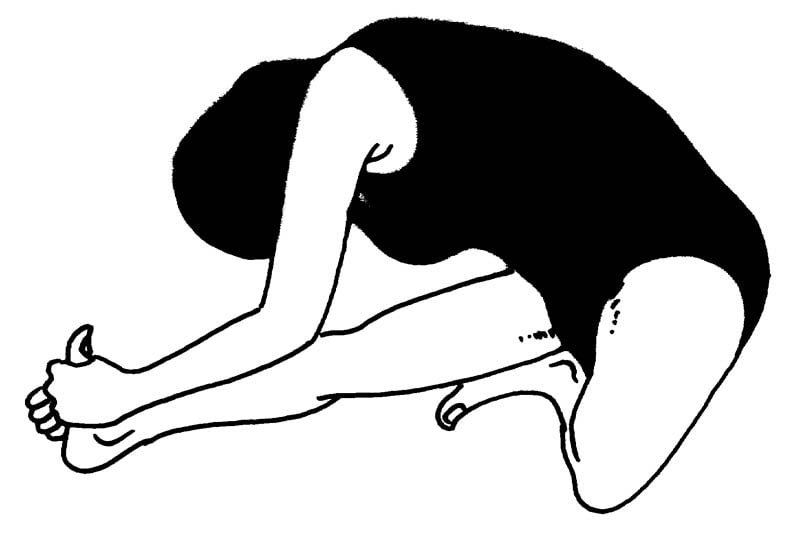
Benefits : This asana strengthens back, legs and abdomen. This asana tones up the upper part of the body and relieves the problems like gas formation and constipation also.
Ushtrasana
This asana has been named after the camel.
Method : Sit erect and let the weight of entire body fall on both knees and toes of feet. Now catch hold of your heels with the hands, as shown in the above figure. While performing this asana, make sure that the back is bent in such a way that neck bends towards feet, back also bends slightly. Look upwards. Stay in the final position as far and as you conveniently can. Retain breath and exhale while getting back to the original (starting) position.

Benefits : This asana strengthens back, spine knees and feet, renders spine flexible. After the asana is over, there may be ache and stiffness in shoulder blades, knees and feet. Toward off all such effects massage these parts with coconut or mustard oil. That asana is capable of increasing height. Pregnant ladies shouldn’t perform this asana as it exerts utmost pressure on abdomen and back, but in normal health condition, they may perform this asana, especially when they have backache. Avoid undue pressure and jerk in any case.
Sinhasana
Yogic exercises should accompany breathing in rhythm only through the nostrils. This asana is an exception where one cannot do so, because the tongue has to be folded and then stretched in two stages.
Method : Kneel down and lower the body to sit on heels as in Vajrasana, except that in Vajrasana the knees are kept close together and in this they are kept slightly apart. Spread both the palms and place them on the knees in a relaxed way. Breath evenly, protrude the tongue and fold inwards to touch the palate. Bend the head a little forward, the chin touching the chest. At the same time exhale through the nose as well as the mouth simultaneously stretching the tongue as much as possible out of the mouth. Widen the eyes and fix the gaze infront.
Remain thus for two-three seconds and not more during the initial days. Once the protrusion of the tongue is completed, you should stop exhaling and hold the breath for two seconds. After two seconds, slowly draw in the tongue and inhale only through the nose and sit erect. Repeat the process again. After a few days of practice, this exercise can be perfected and practised as many times as possible.
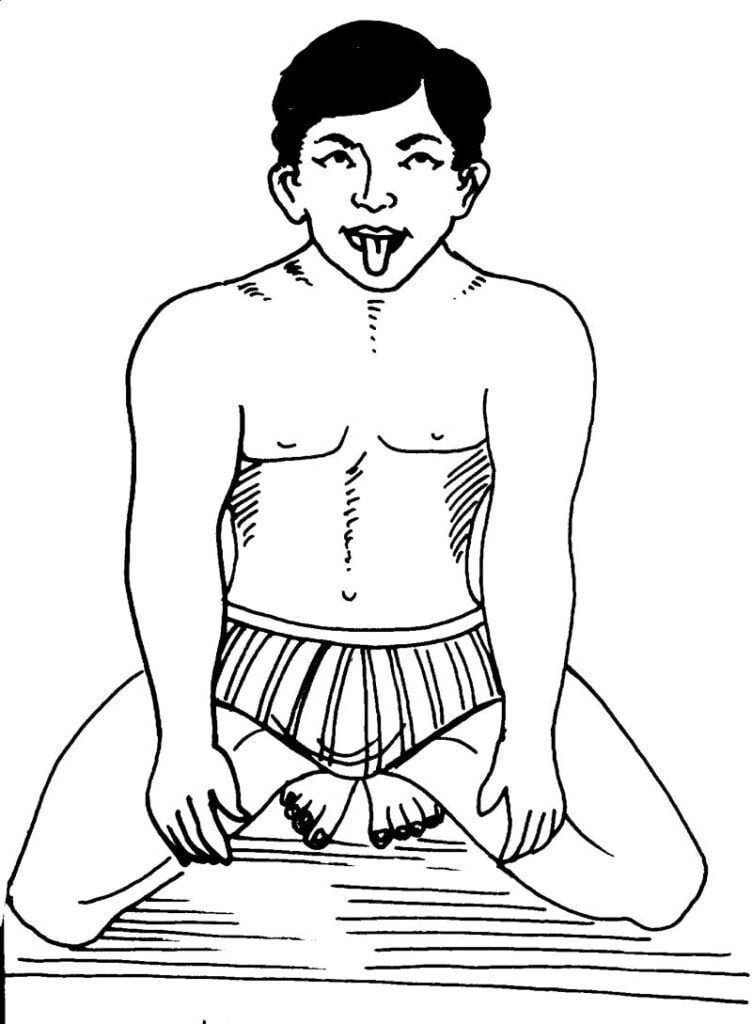
Benefits : This exercise is extremely useful to all young children and must be practised by adults to prevent and cure a number of diseases connected with ear, nose, throat and other respiratory troubles. It helps greatly in overcoming all problems related to tonsils, adenoids, larynx and pharynx. If regularly practised, it can prevent any unnecessary removal of tonsils by surgery. As the face and eye muscles are exercised, it gives a glowing colour to the complexion and shine to the eyes. This exercise proves to be extremely beneficial to singers and public speakers. It is useful in all forms of skin diseases. It cures thyroid diseases and deafness if practised perfectly and regularly.
Mandukasana
This asana must have derived its name for the Sanskrit word Manduka which means a frong. Mandukasana does not resemble the frog very much as its name denotes, but the folded legs resemble frog’s hind legs and the arms supporting the body look like frog’s forelegs. Though this asana looks simple and is also easy to perform, its benefits are plenty.
Method : Kneel down with the knees apart. Slowly lower the body and sit down between the folded legs in such a way that the buttocks touch the ground. Slowly widen the gap between the knees till they come in a straight line. Keep the toes close to each other. Lean a little forward and place both the palms near the thighs, fingers turned towards the thighs. Keep the spine erect, fix your gaze straight and breath normally. Stay so for as long as you can and revert back to original position by releasing the hands first and then drawing in the folded legs together. Relax and repeat again. During the initial days of practice, difficulty may be experienced in spreading the legs and it may not come in straight line. The groins may ache if you force it. Gradually, the gap can be decreased without any discomfort.

Benefits : This is a unique exercise for women, teenage girls as well as women of other ages. All uttering disorders respond well to this exercise. The so-called premenstrual syndrome, like depression, frustration and anxiety can be overcome by practising this asana regularly. It cures impotence in the males. It strengthens the pelvic muscles and improves circulation in the region. It helps control bladder and prostate disorders. Spinal nerves get adequate supply of circulation and they become stronger. It is a good exercise for obesity too.
Ardhamatsyendrasana
This exercise must be practised by almost every one because this asana and Vakrasana are the asanas that strengthen the spine side ways that too in the vertical position. All other asanas performed lying on the back and abdomen bend the spine forward and backward. Doing Vakrasana first helps doing Ardhamatsyendrasana better and easily.
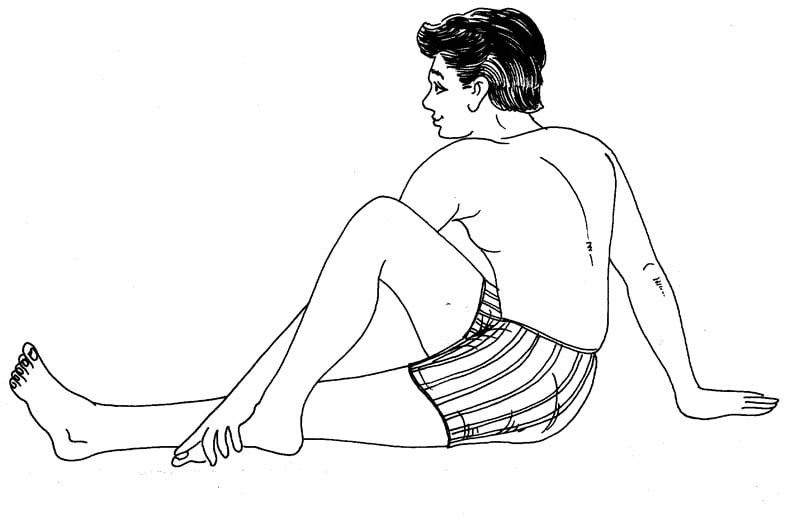
Method : Sit on the ground and place the left heel under the right thigh. Slowly take right leg across the folded left leg and place the foot flat on the ground near the left knee. Push the right leg pressing the abdomen by the left hand and place it touching the right foot or hold the right toes. Twist the waist towards right and bring your chin in level with your right shoulder. Take your right hand behind the back by twisting a little more and touch the right thigh. Stay for sometime in this posture and return to original position. Repeat the same with the other side. Benefits : Useful for backache, digestive disorders, liver disorders, diabetes, kidney disorders and for obesity caused due to diabetes and indigestion.
Shirshasana
This is a topsy-turvy pose in which you stand on your head.
Method : Kneel on the ground. Bend forward and place your arms on the ground at right angle to each other with fingers interlocked. Place your head in your palms and raise the legs slowly till you are balanced vertically on your head. Remain in this position for half to one minute to start with and slowly increase it to 5 or 10 minutes after some months.

Benefits : This is called the king of asanas. Shirshasana invigorates and energises. It is a powerful blood purifier. It cures all diseases of the liver, spleen, lungs and the genito-urinary system. It gradually cures colic, deafness, diabetes, piles, pyorrhoea and constipation. The digestive power will improve. It is best suited for ladies also. Many uterine and ovarian diseases are cured. (Should not be practised during monthly periods and pregnancy). Sterility
disappears. Memory improves remarkably. Eyesight improves. Grey hair disappears. Spinal cord and spinal nerve roots receive an abdundant supply of blood. Sexual energy is increased. Nerves of the body are energised, invigorated and galvanized. Many incurable diseases are cured by the regular practice of this asana. In the beginning you may, if required, start this asana by leaning your legs against a wall until you are able to get independent balance.
Shirshsana should not generally be practised after the age of fifty unless you had practised it before, in which case it can be practised at any age after fifty also.
Shavasana
Method : Lie down on your back. Keep the whole body loose and in a straight position. Palms can be either on the floor or you can keep them upward. Do not use any pillow under your head.
At this point keep breathing in normal way. Keep the eyes closed and let the whole body fall on the floor in an unrestrained way. This position should remain all through the actual practice :

Close your eyes and keep them closed for two seconds. Then open them for two seconds. Do this simple opening and closing of eyes for three to four times.
Open the eyes again and look upward, then downward then straight. Now look towards the left side, then towards the right side, then straight again and then close the eyes. Repeat this eye exercise two to three times.
Now open your mouth wide without straining it. Turn the tongue inside the mouth in such a way that its tip is folded back towards the throat area, then close the mouth. Keep the mouth closed and tongue folded for 10 seconds. Then open the mouth and bring the tongue folded for 10 seconds. Then open the mouth and bring the tongue back to its normal position, then close the mouth. Repeat the process for two to three times.
Keeping your eyes closed, bring your mental attention towards your toes. See (mentally) that the toes are relaxed. Then move slowly upward and towards the head area mentally by checking the knees, thighs, waist, spinal cord, back, shoulders, neck, arms, palms, fingers and rest of the area of the body. To be sure that they are actually relaxed. Make a slight movement of the neck and head by turning right and left. Then let the head rest at a comfortable position. Now the entire body is physically relaxed.
Then relax the mind with the following process : Select a place of natural beauty which you have ever visited and liked, such as park, a garden, a lawn or a riverside and feel as if you are mentally present at that place. Attach your mind to that place. Feel as if you are lying at that place and breathing air of the same environment. Now while keeping the mind involved with that environment, do some deep breathing. In this deep breathing, just exhale and inhale slowly but deeply. During the breathing, the stomach should go upward while inhaling and it should come downward while exhaling. One exhalation and one inhalation make one round. Do not rush in this deep breathing. Make about ten to twelve rounds. When the deep breathing is over, feel as if you are going to sleep. Now relax completely. Stay in that position for 5 to 10 minutes. Then open your eyes and stretch your body and then be seated. You have completed the Shavasana.
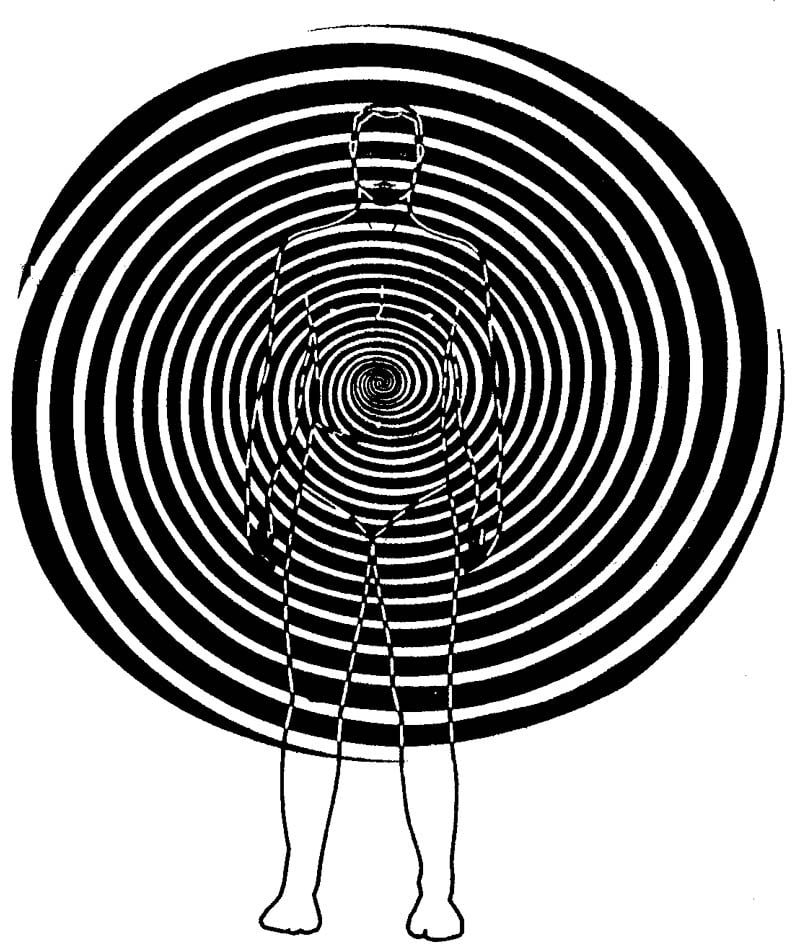
Benefits : Shavasana has a very good effect upon the patient as well as upon any yoga practitioner. One immediate effect is that it relaxes all the muscles, nerves and the organs of the body system. When the muscles, nerves and the organs are fully relaxed, they gain strength and their normal health is restored.
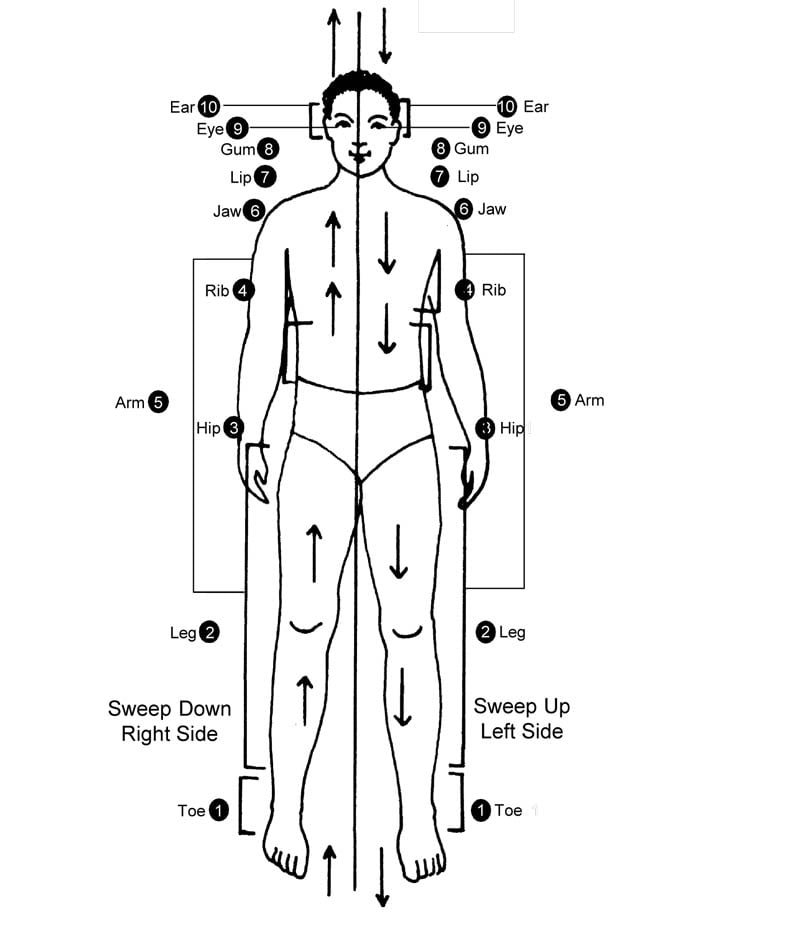
For people suffering from insomnia, high and low blood pressure, gastric trouble, lungs and heart troubles and mental sickness, Shavasana is a remarkable process for providing immediate relief.
Breathing exercises
Some important breathing exercises are given below :
Breathing with rhythm : Sit cross-legged on the ground or on a chair or stand with folded hand as in prayer. Keep mouth closed and breathe in through the nostrils counting one to four. Hold breath till you count from one to eight. Start to breathe out. While breathing out count once again from one to four, hold breath till you count from five to eight before you start inhaling. Repeat this a few more times. Increase the number of counts while breathing in and out and in between, gradually from day to day, to draw in more oxygen and expel more carbon-di-oxide.
Cleansing pranayama : Sit cross-legged on the ground or on a chair with the spine erect and muscles relaxed. Cover the right nostril with the thumb and inhale through the left nostril. Cover the left nostrils too with the index finger and hold breath for one to two counts. Release the thumb and exhale through the right nostril. Repeat this with the left nostril. Cover the left nostril with the index finger and inhale rough the right. Close both the nostrils and hold for one or two counts and then exhale through the left nostril releasing the index finger. With regular practice the number of counts while holding the breath should increase. This exercise corrects the disorders of the nasal cavity and lungs. The good supply of oxygen help purify the lungs.
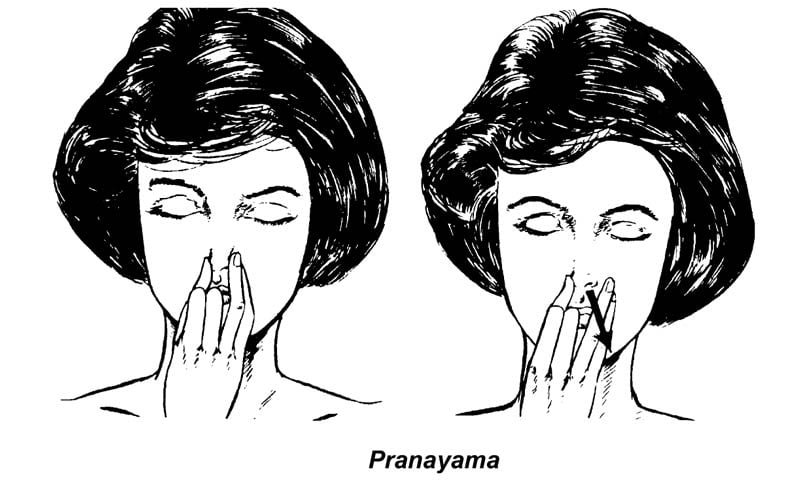
Those who suffer from blood pressure must not practice to hold the breath. They can simply inhale and exhale.
Another exercise : Sit in a comfortable position with crossed legs. Keep the body relaxed and erect. Keep the mouth closed. Inhale fast as much air as possible and exhale quickly with force. Do not hold the breath but breathe in and out in quick succession. Relax a while, breathing normally and again start breathing in and out in quick succession. Do this five to six times in the beginning and slowly increase after a few days practice.

This exercise is recommended in all digestive and respiratory disorders. It corrects defective circulation.

